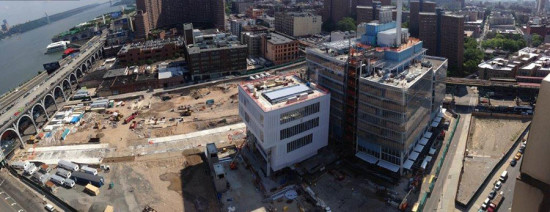
Columbia University’s expansion has been selected by LEED for their Neighborhood Design pilot program, which calls for the integration of smart growth principles and urbanism at a neighborhood scale.
Renzo Piano Building Workshop (RPBW) is designing four buildings to be built over the upcoming years as a first phase of Columbia University’s Manhattanville campus expansion. The first of these four projects to break ground is the Jerome L. Greene Science Center, a research facility used by scientists working on mind, brain, and behavior research. The facility is ten stories wrapped in nearly 176,000 square feet of building envelope, consisting of transparent floor-to-ceiling glazing.

“Columbia’s existing buildings are sited massively on the ground, and the campus— for many reasons—is gated. However, the new Manhattanville campus will express the values of this century: tolerance, openness, permeability, and transparency. It’s a new generation of campus design,” said Antoine Chaaya, the RPBW partner in charge of the Columbia project.

- Facade Manufacturer
Enclos - Architects
Renzo Piano Building Workshop; Davis Brody Bond, LLP (Architect of Record) - Facade Installer
Enclos; Lend Lease (construction manager) - Facade Consultants
Israel Berger & Associates, A Vidaris Company, NY; WSP Cantor Seinuk, NY (Structural Engineer); Jaros Baum & Bolles (MEP Engineer) - Location
New York, NY - Date of Completion
Late 2016 (projected) - System
structural facades, double skin walls, metal and glass canopies - Products
laminated and insulated low iron glass wall assemblies by Interpane
An elevated subway track along the east facade generated 88 dB of noise, which needed to be significantly reduced for occupant comfort. To achieve this, the architects created a double skin facade system that was sealed from the outside. It represents the fourth double skin facade developed by RPBW, and the first to include active air circulation, according to Chaaya. “What helped us to create this fourth typology of double skin is the constraint: The fact that it cannot be permeable to the outside. It has to be sealed, and at the same time we have to fight against potential condensation. We solve the problem by active air circulation from the bottom to the top of the building.” The resulting facade system provides superior blast resistance and thermal properties, while reducing sound transmission by 45 dB.
The cavity of the facade assembly is 18 inches deep, sized just large enough for maintenance access. Highly purified and dehumidified air is filtered three times and slowly cycled up vertically through the cavity at two feet per minute, a rate that ensures quiet operation and no disturbance to shading devices within the cavity. Air in the cavity cycles at a rate of six air changes per minute, managing heat gain and condensation buildup in the cavity.
Variations in the facade are generated from functional responses to solar orientation due to orientation, honestly expressing the interior functions of the building. The result is a sophisticated building enclosure, abiding by a rigorously minimal design aesthetic while nimbly adapting to environmental criteria.


